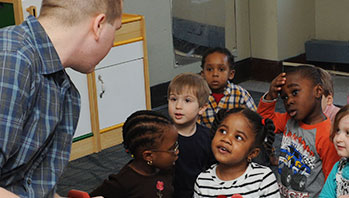- pictures or books of various plants
- plant that is sprouting (from last week’s activities)
- “Plants All Around” chart
- bulb
- plant
- seed
- soil
- sprout
MA Standards:
English Language Arts/Speaking and Listening/SL.PK.MA.1a: Observe and use appropriate ways of interacting in a group (e.g., taking turns in talking, listening to peers, waiting to speak until another person is finished talking, asking questions and waiting for an answer, gaining the floor in appropriate ways).
Head Start Outcomes:
Science Knowledge/Conceptual Knowledge of Natural and Physical Worlds: Observes, describes, and discusses living things and natural processes.
Science Knowledge/Scientific Skills and Method: Collects, describes, and records information through discussions, drawings, maps, and charts.
PreK Learning Guidelines:
English Language Arts/Language 1: Observe and use appropriate ways of interacting in a group (taking turns in talking; listening to peers; waiting until someone is finished; asking questions and waiting for an answer; gaining the floor in appropriate ways).
Science and Technology/Life Sciences 10: Observe and identify the characteristics and needs of living things: humans, animals, and plants.
Talk Together: Sprouting Seeds

© Commonwealth of Massachusetts, Department of Early Education and Care (Jennifer Waddell photographer). All rights reserved.
STEM Key Concepts: Plants start in different ways; Some plants start from seeds; Some plants start from bulbs; All plants are similar and different in some ways
ELA Focus Skills: Compare and Contrast, Listening and Speaking, Vocabulary
Remind children that last week you asked them to notice the plants around their neighborhood and home. Ask them to share what plants they saw. If children did not notice any plants around the neighborhood, ask them to choose a picture of a plant to describe. Encourage children to describe the plant’s color, size, shape, texture, etc.
Then hold up a plant from last week’s explorations that has sprouted. Ask,
- How have the <grass> seeds changed since the last time you looked observed them?
Model the use of key vocabulary, such as sprout, soil, bulb, and leaves, and prompt children to use these words in their responses. (“The bulb has sprouted two leaves.”)
Record new ideas on the “Plants All Around” chart.
Educator Tip: Seeds will grow at different rates, so you will have to vary the seeds/plants mentioned in these activities and focus on the seeds or bulbs that are showing growth.
Educator Tip: If some plants do not sprout at all, use this as an opportunity for a comparison discussion—children can wonder, think, and talk about why some grew and some didn’t, and think about what they might do differently next time.
Social Emotional Tip: Allow children opportunities to express their ideas and opinions so that they begin to understand that others may have different, valid ones.
English Language Learners: Hold up and name each type of seed children planted last week. Have children repeat the name after you.
